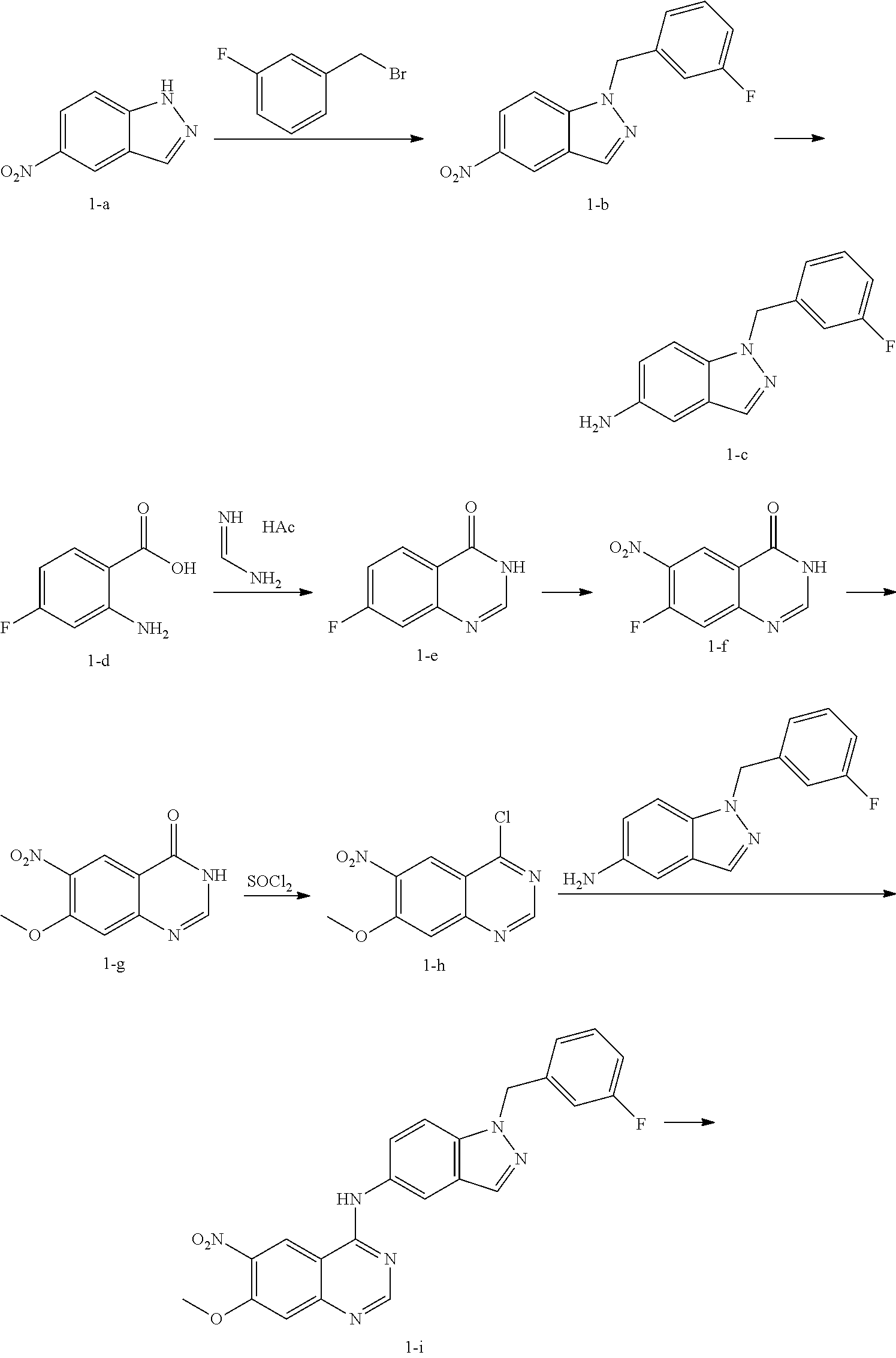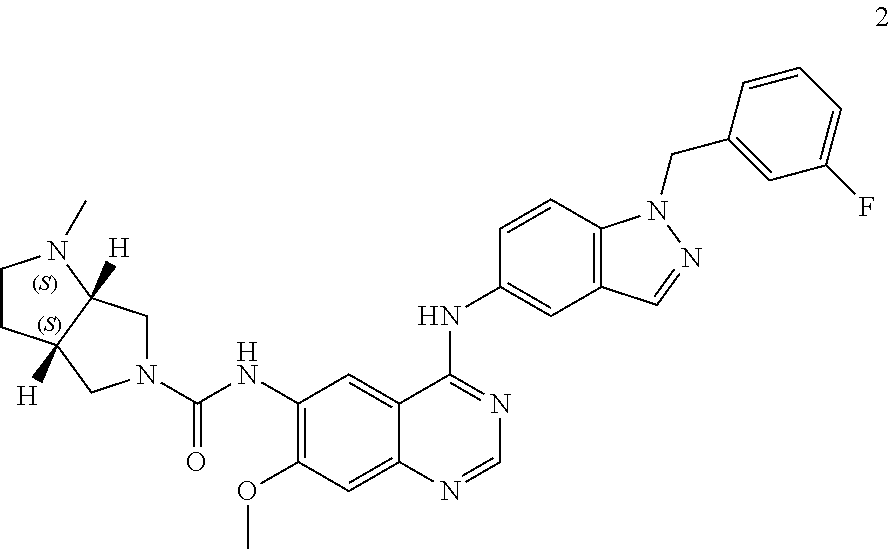Quinazoline compounds
a technology of quinazoline and compound, applied in the field of pharmaceuticals, can solve problems such as uncontrolled cell division, and achieve the effect of inhibiting overexpression and/or overactivity
- Summary
- Abstract
- Description
- Claims
- Application Information
AI Technical Summary
Benefits of technology
Problems solved by technology
Method used
Image
Examples
example 1
(3aR,6aR)—N-(4-(1-(3-fluorobenzyl)-1H-indazol-5-ylamino)-7-methoxyquinazolin-6-yl)-1-methylhexahydropyrrolo[3,4-b]pyrrole-5(1H)-carboxamide
[0081]Compound 1 was prepared according to the following scheme.
[0082]A mixture of 5-nitro-1H-indazole (1-a, 5 g, 30.65 mmol), 1-(bromomethyl)-3-fluorobenzene (3.76 mL, 30.65 mmol) and potassium carbonate powder (4.66 g, 30.65 mmol) in DMF (3 mL) was stirred at 80° C. for 3 h and then poured into water (100 mL). The precipitates were obtained by filtration and further purified by chromatography on silica gel (PE / EtOAc=3:1) to give 1-b (5.3 g, 19.7 mmol).
[0083]Under N2, Raney's nickel (0.53 g, wet weight) was added to a solution of 1-b (5.3 g, 19.7 mmol) in methanol (20 mL) and the mixture was degassed and stirred under hydrogen atmosphere at room temperature overnight. The catalyst was carefully filtered and the filtrate was concentrated in vacuum to give 1-c (4.65 g, 19.3 mmol).
[0084]A mixture of 2-amino-4-fluorobenzoic acid (1-d, 7.75 g, 50 mmo...
example 2
(3aS,6aS)—N-(4-(1-(3-fluorobenzyl)-1H-indazol-5-ylamino)-7-methoxyquinazolin-6-yl)-1-methylhexahydropyrrolo[3,4-b]pyrrole-5(1H)-carboxamide
[0092]
[0093]Compound 2 was prepared according to the procedures of Example 1 under similar conditions using (3aS,6aS)-1-methyloctahydropyrrolo[3,4-b]pyrrole. MS (m / e): 566.8 (M+1)+.
example 3
(3aR,6aR)—N-(4-(3-ethynylphenylamino)-7-methoxyquinazolin-6-yl)-1-methyl-hexahydropyrrolo[3,4-b]pyrrole-5(1H)-carboxamide
[0094]
[0095]To a solution of Compound 3-a (40 g, 0.138 mol, prepared according to procedures disclosed in WO2010002845), pyridine (40 mL, 0.495 mol) and DMF (anhydrous, 22 mL) in anhydrous THF (500 mL), was added phenyl carbonochloridate 3-b (22 mL, 0.175 mol) dropwise at −10° C. The mixture was stirred at room temperature for 12 hours. The precipitates were filtered and then suspended in saturated NaHCO3 solution (500 mL). The solid was filtered, washed with H2O and EtOAc, and dried in vacuum to give compound 3-c (46 g). A mixture of compound 3-c (1 g, 2.44 mmol) and compound 3-d (369 mg, 2.92 mmol) in dioxane (30 mL) was stirred at 70° C. for 5 hours, and then cooled to the ambient temperature. The precipitates were filtered, washed with EtOAc, and dried in vacuum to give compound 3 (0.8 g). MS (m / e): 443.4 (M+1)+.
PUM
| Property | Measurement | Unit |
|---|---|---|
| wet weight | aaaaa | aaaaa |
| wet weight | aaaaa | aaaaa |
| temperature | aaaaa | aaaaa |
Abstract
Description
Claims
Application Information
 Login to View More
Login to View More - R&D
- Intellectual Property
- Life Sciences
- Materials
- Tech Scout
- Unparalleled Data Quality
- Higher Quality Content
- 60% Fewer Hallucinations
Browse by: Latest US Patents, China's latest patents, Technical Efficacy Thesaurus, Application Domain, Technology Topic, Popular Technical Reports.
© 2025 PatSnap. All rights reserved.Legal|Privacy policy|Modern Slavery Act Transparency Statement|Sitemap|About US| Contact US: help@patsnap.com



